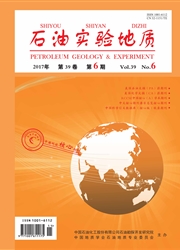

 中文摘要:
中文摘要:
针对中国南方混源多灶多期成藏、多期构造改造与破坏等特点,有必要探索出新的有关油气保存研究的描述方法与研究思路。在总结多年研究成果的基础上,探索性地提出了“保存系统”的概念及研究方法。该概念初步定义为:某一地质单元内与保存条件相关的地质要素、地质作用与过程、成藏功能的有机统一体系。它具有统一的“源-盏”条件、相同或相似地质结构及流体特征、基本一致的油气藏保存(或破坏)过程。一个油气保存系统是油气的一个勘探单元,范围上可相当于一个盆地的二级或三级构造单元,其研究内容包括地质结构类型、盖层封盏性、源-盖动态匹配关系与流体特征等4个方面以及一个综合评价体系。概念与研究方法的提出可更好地适应中国南方或相似多旋回盆地油气勘探的需要。
 英文摘要:
英文摘要:
The reservoirs in South China are characterized by mixed-sources, multiple kitchens as well as multistages of accumulation, deformation and destruction. It is necessary to explore new description methods and research ideas of petroleum preservation studies. A new concept of 'preservation system' and its research methods were put forward in this paper. The 'preservation system' is a unity of geological factors, geological functions and processes, and reservoir formation associated with preservation conditions in a geological unit. This system has an integrate source-cover condition, the same or similar geological structure and fluid characteristics, and the consistent preservation (or destruction) process of oil-and-gas reservoir. A preservation system is an oil-and-gas exploration unit, and its scope corresponds to a second-class or a third-class tectonic unit of a basin. The study content of the preservation system includes 4 basic features (geological structure types, cover functions, source-cover dynamic relationships and fluid characterizations) and 1 comprehensive evaluation system. The new concept and research methods may meet the needs of oil-and-gas explorations in South China or similar polycyclic basins.
 同期刊论文项目
同期刊论文项目
 同项目期刊论文
同项目期刊论文
 Formation mechanism of carbonate cemented zones adjacent to the top overpressured surface in the cen
Formation mechanism of carbonate cemented zones adjacent to the top overpressured surface in the cen Carbonate Cementation-Dissolution and its Study Significance in Deep Sandstone near the Top Overpres
Carbonate Cementation-Dissolution and its Study Significance in Deep Sandstone near the Top Overpres Oil–source correlation for the paleo-reservoir in the Majiang area and remnant reservoir in the Kail
Oil–source correlation for the paleo-reservoir in the Majiang area and remnant reservoir in the Kail Stable carbon isotopic fractionation of individual n-alkanes accompanying primary migration: evidenc
Stable carbon isotopic fractionation of individual n-alkanes accompanying primary migration: evidenc 期刊信息
期刊信息
